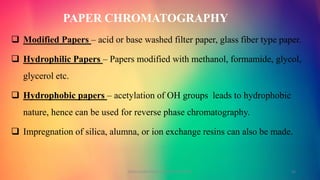The document provides a detailed overview of chromatography, emphasizing its definition, types, and applications in separating mixtures into individual compounds. Key techniques discussed include paper chromatography, its preparation, development methods, and various factors affecting its performance. Additionally, it outlines the qualitative and quantitative methods of analysis used in chromatography, highlighting its advantages in drug and compound separation.



































